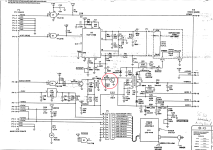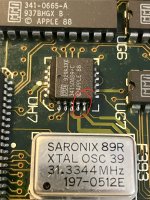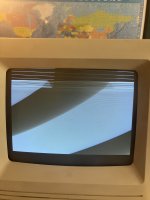trondl
Experienced Member
Hi from Norway and thanks for your time!
To verify some parts from my other SE in service (SE vcfed thread), I thought my SE/30 would be a perfect candidate.
Not so easy. This became a catch 22.
First of, the SE/30 has previously been recapped and thoroughly washed (5 years ago?), corroded solder vias and the nearby chips with dull colour has been reflowed just now.
All is in theory good except for when previously testing the SCSI drive with Lido 7 i get "OSErr= 5 bad scsi command: phase error".
The disk is "fully" accessible though according to the sector reads, apart from trying to format it. This is incredible in it self as this drive was opened to remove gooey rubber years ago.
This I hope I fixed by the recent reflowing of the SCSI controller (dull solder).
Now, the HDD is another problem for later.
What I can see during boot is an intermittent horizontal "collapse" on both sides about a couple of "pixels" in width.
This is even more present when testing said HDD in Lido 7.
My immediate thought was ripple from a shared supply line between horizontal drive and HDD.
I see that there are two 12V lines from the PSU, one for the "Disk" and one for "Sweep" which I guess is the CRT.
First line of attack was the analog board.
Solder inspected for cracks, caps verifiable in circuit verified and unverifiable had one leg freed and verified with ESR tester.
All within reasonable spec.
Next attack was the PSU it self.
All solder points verified, caps on secondary verified-ish out of circuit but measure in the lower uF side of within spec.
I've read that a wobbly horizontal may be a failing HOT, but since this is directly affected by HDD activity, I have my doubts.
Any recommended lines of attack I should consider?
Don't have all the caps for the PSU or analog board in stock atm, but I fear the PSU caps have to be replaced as they're all "weaker".
To verify some parts from my other SE in service (SE vcfed thread), I thought my SE/30 would be a perfect candidate.
Not so easy. This became a catch 22.
First of, the SE/30 has previously been recapped and thoroughly washed (5 years ago?), corroded solder vias and the nearby chips with dull colour has been reflowed just now.
All is in theory good except for when previously testing the SCSI drive with Lido 7 i get "OSErr= 5 bad scsi command: phase error".
The disk is "fully" accessible though according to the sector reads, apart from trying to format it. This is incredible in it self as this drive was opened to remove gooey rubber years ago.
This I hope I fixed by the recent reflowing of the SCSI controller (dull solder).
Now, the HDD is another problem for later.
What I can see during boot is an intermittent horizontal "collapse" on both sides about a couple of "pixels" in width.
This is even more present when testing said HDD in Lido 7.
My immediate thought was ripple from a shared supply line between horizontal drive and HDD.
I see that there are two 12V lines from the PSU, one for the "Disk" and one for "Sweep" which I guess is the CRT.
First line of attack was the analog board.
Solder inspected for cracks, caps verifiable in circuit verified and unverifiable had one leg freed and verified with ESR tester.
All within reasonable spec.
Next attack was the PSU it self.
All solder points verified, caps on secondary verified-ish out of circuit but measure in the lower uF side of within spec.
I've read that a wobbly horizontal may be a failing HOT, but since this is directly affected by HDD activity, I have my doubts.
Any recommended lines of attack I should consider?
Don't have all the caps for the PSU or analog board in stock atm, but I fear the PSU caps have to be replaced as they're all "weaker".





